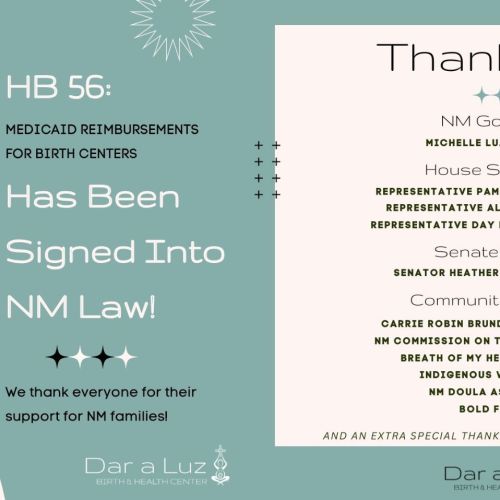Safety of Breastmilk and Breastfeeding during COVID-19 Pandemic: A few answers to some common questions
An update from your DAL lactation team
by Stephanie Sanchez, BSN, RN, IBCLC, Birth Assistant
A few answers to some common questions
I have tested positive for COVID-19 and/or are having symptoms and have just given birth or will soon, will I still be able to initiate breastfeeding?
The conclusion from the World Health Organization (WHO) after conducting a study review this past summer states that: “Based on available evidence, WHO recommendations on the initiation and continued breastfeeding of infants and young children also apply to mothers with suspected or confirmed COVID-19.”
This is very reassuring news in a scary time. While it is still not clear whether the virus can be directly transmitted from an infected mother to her baby through breastmilk, no cases thus far have been able to show this kind of vertical transmission.
Furthermore, the WHO does not recommend any separation of mother and baby after birth due to suspected or confirmed cases, which confirms that the benefits of skin-to-skin contact and establishing breastfeeding outweigh any risks of keeping the babies with their mothers.
Is there any new information on COVID-19 and breastmilk?
At the start of the pandemic, during the fear of the unknown, there was definite concern about the transmission of COVID-19 through bodily fluids, including breastmilk. There were many questions regarding the safety of practices at milk banks accepting “potentially infected milk.” The CDC has since retracted its statements regarding infant separation and the use of donor breastmilk. Ongoing research has yet to find any live virus in breast milk samples from breastfeeding mothers who’ve tested positive for COVID-19. A study done by researchers at UC San Diego on 18 breastfeeding women with confirmed COVID-19 detected only viral genetic material (not live virus) in one of the samples, and subsequent viral culture for that sample was negative. The study concluded that all 18 women had “safe breastmilk;” again, this doesn’t prove that the virus will never be present. They plan to repeat the study on a larger scale.
Researchers in Australia have confirmed that the already established practice of Holder Pasteurization by non-profit milk banks of all donor milk received does indeed kill all of the COVID-19 virus (as well as other viruses that could be present). The researchers spiked breastmilk samples with live virus and then tested it after refrigeration, deep freezing, and pasteurizing. They concluded that cold storage storage did not eliminate the virus, but pasteurization completely wiped it out. Holder Pasteurization is achieved by heating the milk to 145 degrees Fahrenheit for 30 minutes, followed by quick cooling. And while this method does also destroy heat-sensitive immune cells and enzymes — which are beneficial components in breastmilk vs formula — the macronutrients remain intact, thus making pasteurized donor breast milk the preferred option for at-risk newborns (such as preterm infants).
What if my baby requires supplementation?
If your baby requires supplementation for any number of reasons (low blood sugar, high bilirubin, delayed or insufficient milk supply, maternal separation, latch difficulty), available options include pasteurized donor breastmilk (from the Denver Milk Bank), informal donor breastmilk (donated from clients who have been health- and lab-screened), and formula. As far as COVID-19 is concerned, pasteurized breastmilk and formula obviously have the lowest risk. However, if informal donor milk is available to you, it can be pasteurized at home in a similar way to pasteurization at the milk bank. Holder Pasteurization is similar to home canning. You’ll need a large pot on a stove, glass jars or bottles, and a metal-stem food thermometer. Remember, to achieve adequate Holder Pasteurization, the milk needs to maintain a temperature of 145 degrees Fahrenheit for 30 minutes. This article and short video from “Happy Bellies Happy Babies” provides step by step instructions.
Two great resources for informal milk sharing are eatsonfeetsresources.org and happybellieshappybabies.com
Dar a Luz is also happy to facilitate mother-to-mother connections for informal milk sharing: please email Stephanie or Robin if you are looking for donor milk or have milk to share!
Can I get the COVID-19 vaccine if I’m breastfeeding?
Although it will likely be some time before the vaccine is available to our clients (Phase 1 priority groups are high risk healthcare workers and seniors in assisted living facilities), the following is the most up-to-date information we have regarding recommendations while breastfeeding. We will continue to update as new studies and information become available.
The American College of Obstetricians and Gynecologists (ACOG) put out this Practice Advisory statement 12/13/20 regarding vaccinating pregnant and lactating patients against COVID-19:
“ACOG recommends COVID-19 vaccines be offered to lactating individuals similar to non-lactating individuals when they meet criteria for receipt of the vaccine based on prioritization groups outlined by the ACIP. While lactating individuals were not included in most clinical trials, COVID-19 vaccines should not be withheld from lactating individuals who otherwise meet criteria for vaccination. Theoretical concerns regarding the safety of vaccinating lactating individuals do not outweigh the potential benefits of receiving the vaccine. There is no need to avoid initiation or discontinue breastfeeding in patients who receive a COVID-19 vaccine.”
Further vaccine information and recommendations in this advisory statement of important note include:
“At the time of this publication, one vaccine developed for the prevention of COVID-19 has received [Emergency Use Authorization (EUA)] from the FDA. However, COVID-19 vaccines are rapidly emerging and additional EUAs are likely to materialize. ACOG will strive to update this guidance as quickly as possible while maintaining accurate, evidence-based information.”
What are mRNA COVID-19 Vaccines?
Also from the 12/13/20 ACOG Practice Advisory statement:
“The development and use of mRNA vaccines is relatively new. These vaccines consist of messenger RNA (mRNA) encapsulated by a lipid nanoparticle (LNP) for delivery into the host cells. These vaccines utilize the body’s own cells to generate the coronavirus spike protein (the relevant antigens), which, similar to all other vaccines, stimulates immune cells to create antibodies against COVID-19. The mRNA vaccines are not live virus vaccines, nor do they use an adjuvant [like aluminum] to enhance vaccine efficacy. These vaccines do not enter the nucleus and do not alter human DNA in vaccine recipients. As a result, mRNA vaccines cannot cause any genetic changes (CDC, Zhang 2019, Schlake 2012). Based on the mechanism of action of these vaccines and the demonstrated safety and efficacy in Phase II and Phase III clinical trials, it is expected that the safety and efficacy profile of the vaccine for pregnant individuals would be similar to that observed in non-pregnant individuals. That said, there are no safety data specific to mRNA vaccine use in pregnant or lactating individuals and the potential risks to a pregnant individual and the fetus are unknown.”
From the Academy of Breastfeeding Medicine ABM Statement: Considerations for COVID-19 Vaccination in Lactation, 12/14/2020:
“During lactation, it is unlikely that the vaccine lipid would enter the bloodstream and reach breast tissue. If it does, it is even less likely that either the intact nanoparticle or mRNA transfer into milk. In the unlikely event that mRNA is present in milk, it would be expected to be digested by the child and would be unlikely to have any biological effects. While there is little plausible risk for the child, there is a biologically plausible benefit. Antibodies and T-cells stimulated by the vaccine may passively transfer into milk. Following vaccination against other viruses, IgA antibodies are detectable in milk within 5 to 7 days. Antibodies transferred into milk may therefore protect the infant from infection with SARS-CoV-2.”
Although the biology information is reassuring, for definitive information, we will have to wait for data on outcomes once the vaccine is used in lactating individuals and their children.
According to the CDC Advisory Committee on Immunization Practices, with the exception of smallpox and yellow fever, “vaccines during lactation do not affect the safety of breastfeeding for the mother or her child.”
We see you mamas, we know you’re stressed, and anxious, and scared. This is a lot! Know that Dar a Luz staff is here for you and will continue fighting through this pandemic to keep this a healthy and safe place for care for you and your babies. Reach out if we can support you.
XOXO – Stephanie
Resources:
https://www.who.int/news-room/commentaries/detail/breastfeeding-and-covid-19
https://www.cdc.gov/coronavirus/2019-ncov/need-extra-precautions/pregnancy-breastfeeding.html



